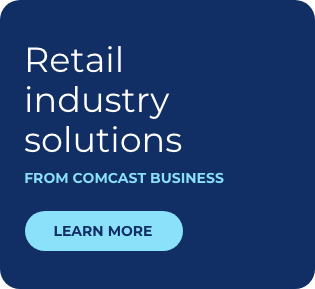Branch Optimization for Retail

Introduction
The retail sector is in a constant battle for mindshare among shoppers. Competition from online retailers, evolving customer shopping behaviors and an increasingly technology-focused customer base is forcing traditional retailers to close stores, consolidate operations and rethink their overall strategy.
But while such moves can help ease the financial strain in the short run, it doesn’t improve a retailer’s chances for longevity in an increasingly digital world. That’s why a growing number of retailers are embracing new technologies to augment the in-store shopping experience and increase the efficiency and productivity of all their locations, from stores to warehouses and beyond, to remain relevant and find continued success.
What’s Driving Optimization in Retail
Retailers with physical locations have sat in the eye of a perfect storm that threatens to destroy their very being. In 2017, more than 300 retailers filed for Chapter 11 bankruptcy, and more than 6,700 stores in the United States were targeted for closure—a number higher than the more than 6,100 stores that closed during the height of the economic recession in 2008.[1]
But although they have taken a hit, physical retailers are not yet out of the game: Most shoppers see value in physical stores to be able to interact with a product before they buy it.[2] At the same time, however, shoppers value the convenience of online transactions.[3] Retailers, therefore, increasingly are looking for ways to incorporate both retail motions into their strategy.
Savvy retailers are using technology more and more to help them create an exceptional experience for their customers that include both in-store and online services. The omnichannel experience, as it is known, allows customers to shop wherever they want—at home or at the mall—and have access to the same inventory everywhere. A melding of physical and digital assets—in-store inventory and ecommerce capabilities—is creating what’s known as an “endless aisle” and paves the way for customization and personalization beyond today’s offerings.
These opportunities can put untold pressure on back-office operations, which traditionally have relied on spreadsheets and basic enterprise resource planning (ERP) systems to inform their decision-making. It’s widely acknowledged the retail sector traditionally is slow to adopt new technologies, the widening gap between in-store and online sales is forcing many retailers to take a look at how technology such as big data analytics can enhance and improve their operational capabilities. Even more mundane-sounding technologies such as those that can better improve inventory motions or streamline logistics are being viewed as potential game changers for retailers looking to move faster and smarter.
The right technologies also can put retailers on the path to the “store of the future,” one in which shoppers walk in, take what they like, tap their mobile device and leave without having to stand in line to check out. Sensors throughout the store record what the shopper picks out and puts back, while a mobile wallet app takes care of payment. All the shopper’s data is collected and stored—including size, preferred style, average sale amount and average length of time spent shopping—to be used for future personalized marketing offers, for example. Sales associates, meanwhile, are freed to engage with customers more meaningfully, such as suggesting items based on customers’ purchase history, which can lead to greater customer loyalty.
Benefits of Optimizing in Retail
Indeed, finding ways to connect with customers on a deeper level is important—if not critical—for retailers in today’s highly competitive environment. Understanding customers’ needs and providing them not only with what they need but also what they might want can help retailers increase sales and improve customer loyalty. And helping them shop the way they most prefer, such as trying on and paying for items in store but delivering the items to the customer’s home within a specified time—instead of customers having to carry around their purchases while they shop—can further customer loyalty even more.
Other ways in which retailers can help customers shop the way they most prefer is through the use of kiosks or tablets to enable instant or self-checkout or to look up in-store inventory and even order “custom” versions of items, such as a skirt with a leather trim instead of a fringe or a red jacket with black buttons instead of brown buttons, for instance. This ability creates an endless aisle, wherein retailers are able to offer customers what they want in the color, cut and size they want. The items, once selected and paid for, are then custom created and shipped to the customer’s home or preferred location.
Some retailers are offering customers what they want not through an endless aisle, but through a “store in a store.” Sephora stores located within JC Penney locations is a prime example of the store-in-a-store concept: Each store is a separate entity housed in the same location, with separate sales staff, separate transactional systems and separate operations. Stores in stores are designed to make shopping more convenient by providing customers with one-stop-shopping and by providing a one-to-one relationship between expert—the Sephora employee, in this example—and customer.
To ensure a balance of customer satisfaction and operating efficiency, optimization at all levels must occur at every location within a retailer. Physical stores must be able to connect with each other to access inventory and other information, while both stores and web-based commerce entities must be able to connect with warehouses to ensure inventory is available at all times. Likewise, warehouses must be in contact with logistics teams to ensure timely arrival of new inventory and coordinate shipments to stores or to customers directly. And operations needs visibility into all transactions to ensure each location is stocked and managed appropriately.
Examples of Optimization in Retail
Technology is the backbone of optimization in the retail sector, providing retailers with the necessary tools to engage with customers longer and more deeply. Whether the goal is to make shopping more exciting or more convenient, retailers are relying on technology to create exceptional customer experiences.
Mobile technologies such as location-based social networking apps and augmented reality are enhancing the in-store experience for many customers. For example, The North Face developed its mobile app to deliver personalized content based on the user’s location, including information such as the address, business hours and a map to the closest store, as well as weather conditions locally and in other cities. Customers can use the app to shop online or, while in-store, to scan product barcodes to learn more about product details, read reviews, watch videos and even get recommendations for other products before making a purchase.[4]
In the same vein, Neiman Marcus developed its app that automatically recognizes customers when they walk into a store and notifies their favorite salesperson. The app also keeps the customer’s preference information, such as styles or favorite colors, which the salesperson can use to better understand and more intelligently service the customer.[5]
Nordstrom, meanwhile, has a digital strategy that blends in-store with digital experiences, such as shopping online and picking up merchandise curbside. Additionally, the retailer is enabling customers to reserve apparel online and try it on in-store before purchase, saving the potential headache of returns.
The company is now also experimenting with a new concept store it calls “Nordstrom Local,” which doesn’t carry inventory but offers personal shopping services as well as alterations and salon services such as manicures. Customers using Nordstrom’s personal shopping service can visit the Nordstrom Local to try on their selections in a more personal, relaxing atmosphere than a mall environment. The idea, said co-president Blake Nordstrom, is to drive increased customer engagement and market share.[6]
Beyond apparel, Coop Italia is transforming the food shopping experience through a strategy that involves heavy doses of analytics to determine everything from the store layout to product placement on store shelves. Interactive tables located throughout the store displays products and shows augmented information about the product, including nutritional facts, any allergen information, location of origin and even waste disposal instructions. Shelves have been equipped with touch screens that enable customers to navigate through and filter selections to find the right products that suit their needs. And a large screen in the store shows information in real time such as daily events and offerings and the store’s social media interactions.[7]
Technology to Optimize Retail Locations
Retail locations need technology that will enable them to provide a superior customer experience and work at peak efficiency. Wired and wireless connectivity, robust voice and data solutions and data center and cloud connectivity are the elements of a robust yet flexible and agile network.
As retail continues to evolve to meet the needs of customers, a modern IT infrastructure is necessary in providing the right connections. Retailers need technologies such as advanced, cloud-based voice services that interoperate with productivity apps and can move seamlessly from office phone to mobile device without losing connectively. In addition, direct Ethernet connections to the cloud provide reliability for always-available inventory and shipping information and ensure security and integrity of sensitive business-critical and customer data.
In building the network for optimized retail locations, organizations should consider an environment that includes both on-premises and cloud, and networking technologies such as SD-WAN and high-speed broadband to better manage business applications across all locations. And networking components such as WiFi and unified communications can ensure everyone involved at every location can interact and transact using their preferred method of communication.
Working with a network service provider can build and maintain a modern network capable of handling the bandwidth-intensive needs of various technologies today and in the future. By working with a third-party network services provider, organizations can leverage virtual and physical private Ethernet connectivity to assure there are no gaps in network performance and availability for critical applications at the various locations with various business purposes. They also can receive all or some of their most critical connectivity functions as a managed service, including managed connectivity, WiFi, security, voice and business continuity, among others.
Conclusion
The retail sector continues to evolve as competition from online retailers and evolving customer shopping behaviors threaten brick-and-mortar retailers. Retailers, therefore, must embrace new technologies to augment the in-store shopping experience and increase the efficiency and productivity of all their locations to remain relevant and profitable.
View Branch Optimization for Retail.
[1] Jackie Wattles, “2017 just set the all-time record for store closings,” CNN Money, Oct. 25 2017, http://money.cnn.com/2017/10/25/news/economy/store-closings-2017/index.html
[2] “2018 retail, wholesale and distribution outlook | An industry in transition,” Deloitte, 2018, https://www2.deloitte.com/content/dam/Deloitte/us/Documents/consumer-business/us-cb-retail-wholesale-distribution-outlook-2018.pdf
[3] Ibid
[4] The North Face website https://www.thenorthface.com/help/mobile.html
[5] “Eight megatrends driving disruption,” EY, https://betterworkingworld.ey.com/digital/8-megatrends-driving-disruption
[6] Jamie Grill-Goodman, “5 Ways Nordstrom is Engaging Shoppers,” RIS News, Nov. 15, 2017 https://risnews.com/5-ways-nordstrom-engaging-shoppers
[7] “Food Shopping Gets a Dash of Innovation: Coop Italia Reinvents Grocery Shopping,” Accenture, 2017 https://www.accenture.com/us-en/success-coop-italia
Retailers must embrace new technologies to augment the in-store shopping experience and increase the efficiency and productivity of all their locations.
Locked Content
Click on the button below to get access
Unlock NowOr sign in to access all content on Comcast Business Community
Learn how Comcast Business can help
keep you ready for what's next.











